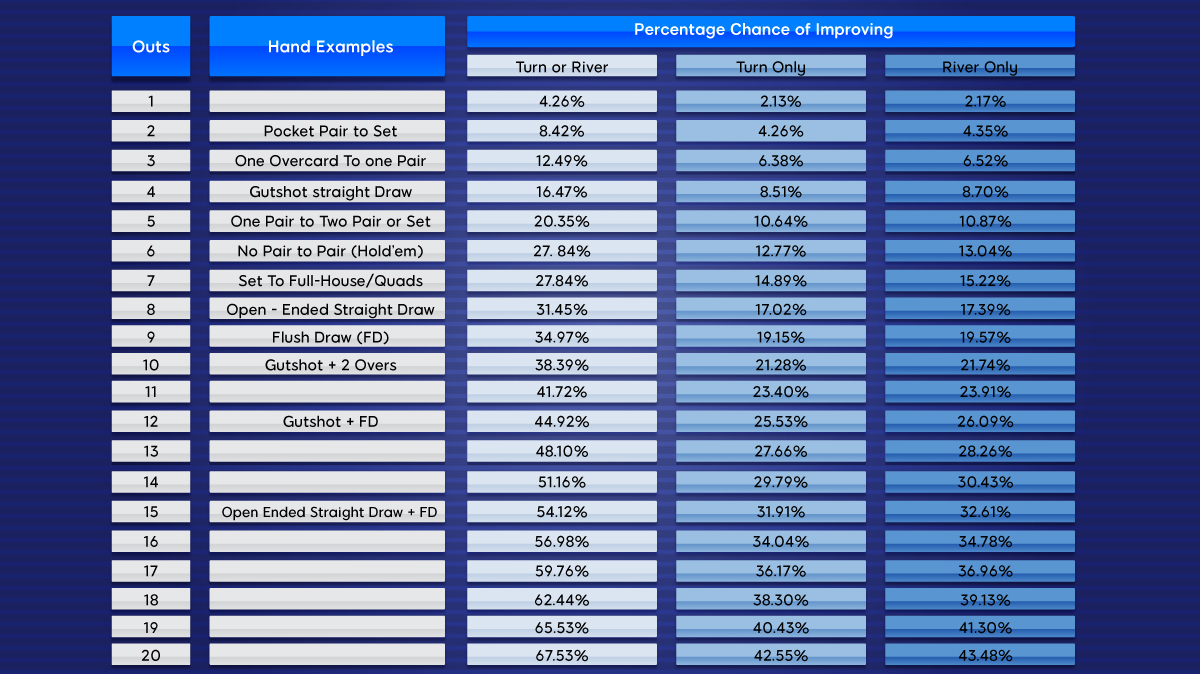- Poker Counting Odds And Outs Games
- Poker Counting Odds And Outs Game
- Poker Counting Odds And Outs Printable
To calculate the percentage by hand, use any of the following approximations:. For example, using the Goodapproximation, if you have 9 Outs, then you have a 19% chance on the turn, a 19% chance on the river, and a 38% minus 19% of 19% (close to 20% of 20%, which is 4%) equals a 34% chance on the turn and river combined. You must win 1 out of 5 times or 20% to break even ($12,500/$2,500 = 20%) Your pot odds are expressed as 1:4. In other words, you must win one pot and lose four pots to break even. If you win more than that, you will make money. When the odds of drawing a card that wins the pot are higher than the pot odds, the call has a positive expectation. In other words, on average, you will win more money than what is costs to call the bet. Your hand odds are, 47 minus the number of outs, divided by the number of outs. An example will help. Say you have an open ended straight draw, you have 8 outs. Your hand odds are.
One of the most outdated perceptions of poker is that it is played by shady characters with strange psychic powers, who read opponents' minds by staring deep into their eyes. These days poker – especially online – relies more on very solid understanding of the mechanics of the game, combined often with a thorough working knowledge of mathematics. It is a far less mysterious business.
Poker Counting Odds And Outs Games
There is no doubt that the very best poker players have actually taken matters even further into the mathematical realm. Some players analyse hands incredibly closely and make numerous in depth mathematical calculations to determine how they will play.
Poker Counting Odds And Outs Game

Poker Counting Odds And Outs Printable

Poker Counting Odds And Outs Printable
But not everyone needs to approach the game like that, particularly not beginners.
As the many PokerStars School courses progress, some of the mathematical aspects of the game will become more prominent. But at this stage, it is only really necessary to have a general idea of some of the core concepts.
Crown casino perth currency exchange rate. One of the very easy calculations you should learn even at this stage in your poker career concerns counting your 'outs'.
Pot odds are the ratio of the current size of the pot to the cost of a contemplated call.
For example, if there is $7,500 in a pot and villain bets $2,500. There is now $10,000 in the pot. It will cost you $2,500 to win a potential $10,000. If you make the bet the pot will be $12,500. You must win 1 out of 5 times or 20% to break even ($12,500/$2,500 = 20%)
Your pot odds are expressed as 1:4. In other words, you must win one pot and lose four pots to break even. If you win more than that, you will make money.
When the odds of drawing a card that wins the pot are higher than the pot odds, the call has a positive expectation. In other words, on average, you will win more money than what is costs to call the bet.
Conversely, if the odds of drawing a winning card are numerically lower than the pot odds, the call has a negative expectation. On average, you will win less money than what it costs to call the bet.
Implied Odds
Implied odds are our potential winnings by the end of the hand compared with the amount of money required to make a call. They are different than pot odds because they account for possible future betting.
Implied odds are calculated in situations where you have a draw. You expect to make money on additional bets if your draw is made. You can fold to a bet on the next card if the pot and implied odds are unfavorable.
Since you expect to gain additional money in a later round, or rounds, when your draw is made, and not be committed to lose additional bets when your draw is missed, the extra money you expect to gain is added to the current pot size.
What you may gain is only an estimate depending on our read of the other player. It isn't an exact science.